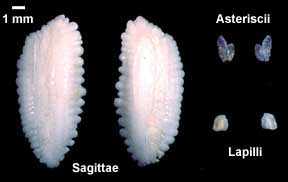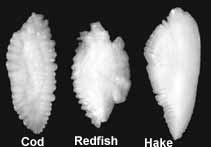What is an Otolith?
Otoliths, or "earstones", are found in the head of all fishes other than sharks, rays and lampreys. These pearly white stones are about the size of a pea, and can be found in the fish's skull just below the rear of the brain. They are not attached to the skull, but rather "float" beneath the brain inside the soft, transparent inner ear canals.
There are 3 pairs of otoliths in each fish; 1 large pair (the sagittae) and 2 small pairs (the lapilli and the asteriscii). It is the largest pair which is usually used for determining age. The smaller pairs are about the size of the tip of a pin. Despite their size however, the smallest pair (the lapilli) is most often used for daily ring ageing.
Otoliths are rocks, not bones. This property makes them more durable than bone. Indeed, the growth of the otolith is a one-way process: new otolith material can be (and is) added to the outside surface through time, but existing material cannot be removed. This one-way growth process explains why otoliths can form and retain such delicate structures as daily rings, whereas bone cannot.
Otoliths have a very distinct shape which is characteristic of the species of fish. That is, different fish species have differently shaped otoliths. Indeed, the shape is so distinctive that biologists can use the otoliths recovered from seal and bird stomachs and droppings to determine the type of fish they ate. Even the size of the otolith can be used to indicate the size of the fish that was eaten.

